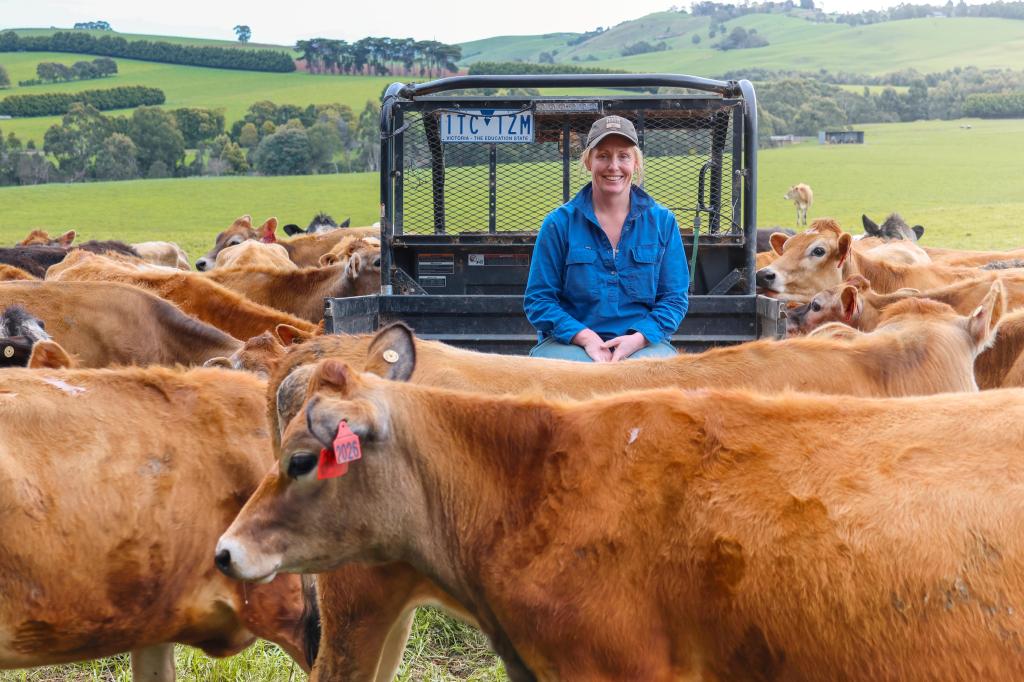Early adoption pays off for South Gippsland Jersey herd
Walk into the heifer paddock at Kylie Reid’s farm and you are met with a sea of even, inquisitive Jerseys. These replacement dairy heifers – minus the few ABS Beef InFocus™ animals – represent the next generation for Kylie, her husband Mark and their children Alannah 17, Campbell 16, and Lily 14. What you don’t see, or it’s not immediately obvious, is the improvement in genetic gain these animals represent.
When the Leongatha North dairy farmer shares her genomic test results, the numbers don’t lie. In one year, Kylie gained more than 20 index points across all three Australian breeding indices. This means that the heifers born in 2022 were 28 points more on the Health Weighted Index (HWI), at about 137 HWI, than those born in 2021. The gain on the Balanced Performance Index (BPI) was 23 to about 144 BPI and 24 for the Sustainability Index (SI) – a measure of greenhouse gas emission intensity produced by animals – up to 297 SI.
The key to this rise in genetic merit is thanks to a focus on sexed genetics, artificial insemination and retaining only the best heifers – born in a tight group at the beginning of calving. “We’ve been using sexed (genetics) on the heifers since 2014,” Kylie explained. “It made calving shorter; we’d start calving on June 22 and finish at the end of August. We’d keep all the heifers born up until July 31 and they were nice and close together. It made the heifers bigger when they were joined.” Breeding more heifers – faster – is one part of the genetic gain equation. The other includes using good bulls and retaining the AI-bred calves.

In recent years Kylie has used a lot of ABS Sexcel Forest Glen Craze TRIPP. In fact, she was so impressed with the proof of the outcross sire that she has 12 TRIPP heifers milking and another 31 to come in next year. “With TRIPP he’s got good fat, milk, protein, fertility, good teat length and chest width,” Kylie said. “We breed for fertility and milk. There’s no point having a cow with no fertility and milk, they are production animals, you want them to produce. If they look pretty, that’s a bonus.”
TRIPP now has more than 30 daughters milking in Australian herds and has rocketed up the Australian Breeding Value (ABV) charts to 390 BPI. Twelve of those daughters are two-year-olds milking in Mark and Kylie’s herd of 278 Jerseys – calving seasonally – in South Gippsland. Their best TRIPP heifer has a PI of 117 and the 12 average 103 PI.
The Reid’s herd, share farmed with Kylie’s parents, Nick and Leonie Murphy, produced a total 138,153 kilograms of milk solids last season. Sires of the calves on-the-ground bred from the TRIPP heifers include ABS 4465 LAWSON – a genomic sire at 297 BPI – and ABS MARINE at 282 BPI.
Since beginning to share farm 10 years ago, Kylie has worked hard to make the most of the “top” genetics her parents built up by collecting and using more herd data. As part of this quest, Kylie began genomic testing heifers and is into her third season of using information from these DNA tests. She said data ensures all the hard work of breeding – using good bulls – isn’t wasted and that information can then be used to make future decisions.
ABS Gippsland Key Account Manager Brian Enbom said Kylie’s work is paying dividends. “Kylie and Mark were using sexed genetics a long time before many Jersey herds embraced the technology,” he said. “This, and their focus on using good sires, coupled with excellent record keeping, is delivering gains on the ground, where it matters. I’ve been working with Kylie, Mark, Nick, and Leonie for a long time now and it’s exciting to see where the next generation is taking the farm business.”
